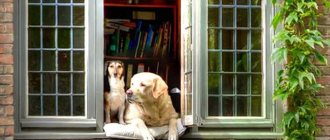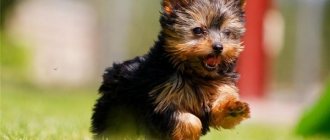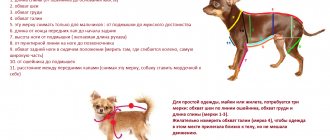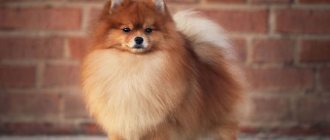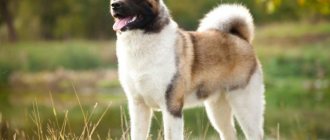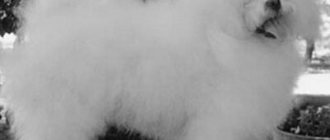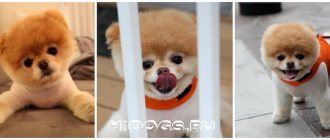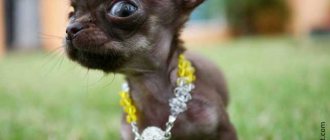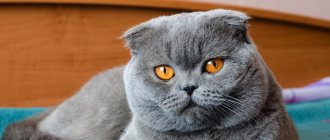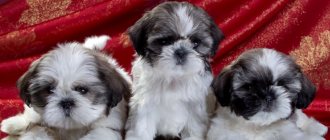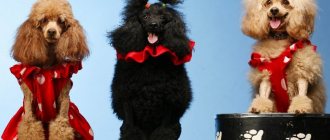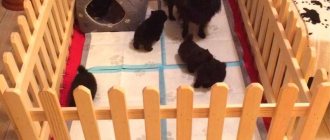They say that money cannot buy true love. But this is not entirely true. By buying a dog, you are acquiring not just a friend, but a creature infinitely in love with you, ready to faithfully follow on your heels, watch for the slightest changes in mood and be always there. Most dogs have these qualities, but not all breeds can be called successful for keeping in a small living space.
What kind of dog is better to have in an apartment? What criteria should you use to choose a pet? And what pitfalls are typical for popular “apartment” breeds? FAN journalist looked into these issues and compiled the top dogs for an apartment - from small to large breeds.
Which dog should I buy for my child?
Having a four-legged family member has many advantages. Thanks to regular communication with animals, children quickly make new acquaintances and feel more relaxed in society.
The need for care also plays a significant role. Despite the fact that most of the responsibilities fall on the parents, kids can also feed, brush and walk their pet. This increases their discipline and sense of responsibility.
When choosing a new pet, it is important to consider the following factors:
- age of the future owner;
- footage of living space;
- size and sex of the animal;
- features of care;
- presence of an allergic reaction to wool.
Please note that the final decision must be made jointly. Only a teenager can completely delegate the care of a dog, but even here there will be some restrictions. For this reason, the puppy chosen must meet the wishes of all family members.
Age: infant, preschooler or teenager
When choosing a dog for a child, be guided by his age. Existing restrictions can be divided into 3 categories:
- Baby. Babies under one year old are unlikely to demand a pet from you. In this case, we are talking about your own desire. The safest option is large breeds that are good-natured and nanny dogs.
- Preschooler. If your preschooler is no more than 3 years old, then teaching him how to properly handle animals is quite problematic. At a later age, he can be explained how to communicate with a pet, and even assigned to some responsibilities. In the first case, focus on options for a baby, and in the second, on breeds that do not require complex care.
- Teenager. During adolescence, children are as independent as possible. If you are confident in your child’s responsibility, let him make his own choice. In this case, any dog listed below will do.
Please note that preschoolers should only interact with their pets in the presence of an adult. By carelessness, they can injure a small dog or accidentally get injured by a large four-legged animal during play.
For a country house or apartment
The best dog breeds for home and children are guard, herding and hunting dogs. The first will guard your site, the second will keep an eye on their little owners, and the third will be able to independently satisfy their need for activity.
An apartment imposes more restrictions. A small living space is not suitable for large and active dogs. Small dogs, as well as calm couch potato pets, are adapted to life in such conditions.
Pet size
The size of the animal affects not only the conditions of its keeping, but also its character. Small dogs are more capricious and jealous. They do not tolerate rough treatment and can bite a naughty owner without warning.
Large dogs are difficult to injure, so they are always more patient than small ones. The only caveat is the difficulty of walking. A large pet is a reliable guard, but not every adult is able to keep it on a leash, let alone children.
Easy to care and feed
A dog for a child should be as easy to care for as possible. Otherwise, almost all responsibilities will fall on you. It is recommended to avoid long-haired representatives and breeds with problem ears or eyes.
Separately, it is worth noting feeding. It is possible to explain to a child the dangers of feeding only at a conscious age, so you should not take a four-legged pet with allergies or a tendency to be overweight.
Male or female
We must not forget about gender. Males are more dominant and less flexible. They often get into fights and react very violently to bitches in heat. Because of this, it is problematic to walk with them unaccompanied by adults.
Bitches are more obedient and often perceive their small owners as their own puppies. Difficulties with walking arise only during heat, but this can be avoided by sterilization.
Despite gender differences, not all animals conform to them. There are always exceptions, so you should additionally focus on the character traits inherent in a particular breed. “Energizer dogs” are suitable for active kids, and phlegmatic dogs are suitable for calm kids.
Having an allergy to wool
A dog for a child with a hair allergy should either be hairless, rarely shed, or have a special hair structure. Please note that these features do not exclude the occurrence of a reaction to other allergens: saliva, urine, sweat, secretions of the sebaceous glands, dandruff and dead skin particles. For this reason, doctors recommend that allergy sufferers not buy pets with excessive salivation.
To be safe, try introducing your baby to the puppy before purchasing. If staying in the same room for 1-2 hours does not cause a negative reaction, then with a high probability it will not occur in the future.
Lhasa apso
Lhasa Apso is included in the list of the most ancient breeds. Small long-haired dogs served as guards in ancient Tibetan monasteries, barking to announce the approach of strangers. The breed gave rise to other Asian decorative dogs and came to Europe in 1929.
The height of the Lhasa Apso ranges from 22 cm in females to 28 cm in males. The long, heavy coat grows to the ground and completely covers the dog. The guard hair is straight, hard, does not fluff or curl. The drooping ears are framed by long hair.
Any colors are allowed. Lhasa Apsos tend to be dominant and can sometimes be difficult to train. The average lifespan is 15 years, but there are long-lived dogs over 20 years old.
The kindest dog breeds for children
First of all, choose dog breeds that love children. They are distinguished by a good-natured disposition, easygoing nature, calm character and lack of aggression towards humans.
Retrievers
The most popular breeds for families are the Labrador Retriever and the Golden Retriever. Both four-legged animals were bred for hunting, but due to their extraordinary love for humans, most owners acquire them as companions. They are not suitable for protection, but they help cope with depression, charging them with optimism.
Sheltie (Shetland Sheepdog)
Shelties are incredibly loyal and have an inexhaustible supply of energy. They have a special love for playing with their owner, which is very important for building relationships with children. Shelties cannot stand loneliness, so a noisy company of children is a priority for them.
Bulldogs
The friendliest bulldogs are English and French. They love children's company, but are slightly different in character. “The English” are lazy and love to sleep, so they are ideal for calm children. The “French” are their opposite with an inexhaustible supply of energy.
Poodle
All varieties, including the smallest ones, are distinguished by their extraordinary intelligence and love for an active lifestyle. Poodles perceive human speech well, quickly learn new commands and are happy to be trained under the guidance of little ones.
Welsh Corgi
Both Pembrokes and Cardigans are famous for their kindness, but the former are most often kept as pets. Cardigans are more phlegmatic, but they also love to play around. Please note that corgis looking after their little owners may lightly bite them on the legs when they deviate from the desired trajectory. In this way, they demonstrate their shepherd instinct, protecting their owners like a herd of cows or sheep.
Border Collie
This dog ranks 1st among the smartest. Border collies quickly learn new skills and perfectly follow any commands. They have a special love for their owners and happily tinker with the little ones all day long.
Bernese Mountain Dog
A four-legged giant with an unusually charming smile reaches psychological maturity only by 2 years. At this age, his curiosity and carelessness are replaced by calmness and equanimity, but this does not at all prevent the mountain dog from participating in any outdoor games with the same zeal.
Newfoundland
This big guy is famous for his heroism and kindness. He loves to communicate with people and gets along well with any pets, including cats and birds. The Newfoundland is also very attached to its family and has a very difficult time being separated.
Setters
Irish and Scottish Setters are ultra-social and require very long, active walks. Up to 3 years of age they are hyperactive and love to play pranks. They cannot stand loneliness and gladly accept any affection, including strong hugs from babies.
Dalmatian
Without regular physical activity, the Dalmatian becomes uncontrollable, so it is recommended to keep it in a private home with the possibility of free walking. This pet is not suitable for children under 3 years of age. The Dalmatian may accidentally injure them during play, not calculating his weight, or instinctively attack due to congenital hearing problems. In the latter case, it is important to explain to the baby that you cannot approach the animal from the back or wake it up during sleep.
Basset Hound
Bassets are unusually sociable and cheerful, but this does not at all interfere with their love for the sofa lifestyle. They are not at all characterized by aggression, so in the event of a robbery it is better not to count on them.
Beagle
A cheerful and energetic good-natured fellow loves to frolic in the fresh air. Thanks to his love of games, he quickly becomes a friend to children. The Beagle easily finds a common language with other dogs, but it is better not to introduce it to cats, rats, hamsters and parrots due to its developed hunting instinct.
Cavalier King Charles Spaniel
A shaggy fidget with an unusually charming appearance is in a positive mood 24/7. Regardless of a person’s age, the Cavalier King Charles becomes very attached to him. Due to his lack of attention, he can cause some pretty serious damage to your home.
Maltese
The ancestors of the Maltese supposedly lived on the island of Malta more than 2 thousand years ago. These are small white dogs with an elongated body and long, smooth hair. It grows to the floor, often exceeds the height and covers the body and limbs with a continuous mantle. The hair does not fluff, does not curl, there is no undercoat.
The height of Maltese dogs is 20 – 25 cm, body weight is 3.5 kg. But the breed produces dwarf dogs. Mini Maltese grow up to 17 - 20 cm, weigh 1.5 - 2 times less than standard ones. In addition to white, pale orange and ivory are also available. The Maltese is called the most intelligent and responsive among decorative dogs.
Small dog breeds for children and apartments
Small dogs are not suitable for all children. They are easily injured and often get sick, which is due to the fragility of the bones and the characteristics of any decorative breed. Despite this, small dogs are ideal for apartment conditions. They are easily litter trained and do not need long walks.
Yorkshire Terrier
Despite its modest size, the Yorkie is a typical terrier. He is energetic, resilient and very courageous. Due to its innate curiosity, the Yorkie is often distracted during walks, but never moves too far away from the owner, preferring to keep him in his field of vision.
Dachshund
Dachshunds are not suitable for melancholy owners, but they get along well with people who prefer an active lifestyle. These four-legged animals are known for their independence and stubbornness, so it is better to train them together with an adult.
Shih Tzu
Another great dog for children is the Shih Tzu. She is not cowardly, has good self-control and does not worry about trifles. The only thing that can throw her off balance is long-term loneliness.
Pekingese
Fluffy Pekingese are peaceful towards any pets, but they are more selective towards children. Due to the low pain threshold and love for a peaceful environment, they are suitable exclusively for teenagers and preschoolers who know how to restrain their emotions during hugs.
Miniature Schnauzer
These small four-legged animals cope well with the role of protector and hunter. Despite their rather serious nature, miniature schnauzers are very good-natured around the family. They show a particularly caring attitude towards children, with whom they can have a lot of fun while playing.
Pomeranian Spitz
Pomeranians become so attached to their owners that they prefer to share the same bed with them and even take a shower. Despite their friendliness, they are quite capable of standing up for themselves and do not accept cruel treatment at all. For this reason, Spitz, like Pugs, are more suitable for conscientious children.
Papillon
The Papillon is the only small dog for children to be included in the top ten smartest breeds. Despite his acute intolerance to loneliness, this four-legged animal never stoops to damaging furniture and constantly looks at the world through rose-colored glasses.
Pug
Pugs are friendly to all people, regardless of their age and the fact of their acquaintance. During games, it is important to take into account the weak feature of the breed - large and bulging eyes. They are easily injured and prone to falling out.
American Cocker Spaniel
This spaniel is quite fastidious in grooming, which is still rewarded by the dog’s luxurious appearance. You will have to comb your cocker almost every day and it will still be difficult to get rid of the fur.
American Cocker Spaniel. Photo: Colin Meeks Otherwise, this smart and good-natured dog makes an excellent apartment pet.
What dog breeds are suitable for children with allergies?
Be sure to check out the list of four-legged friends for allergy sufferers. Although hypoallergenic, the breeds listed below have completely different personalities and sizes.
Basenji
The Basenji cannot bark, practically does not smell like a dog, and is famous for its cleanliness. Due to the lack of undercoat and low shedding, it is classified as conditionally hypoallergenic. That is, it can cause allergies, but much less often than other dogs.
Komondor (Hungarian Shepherd)
The corded coat of Komondors does not cause allergies and does not require complex care. These four-legged animals are extremely loyal to children, but only to acquaintances. They are suspicious of others due to their pastoral background.
Bolonki
Maltese (Maltese) and Bichon Frize (French) hardly shed and do not have a specific dog smell. Both dogs are famous for their mischief and energy. The main difference between these breeds is the extraordinary jealousy of Maltese dogs.
Chinese Crested
These four-legged animals are hairless and downy, but both are hypoallergenic. Chinese Cresteds idolize their owners and cannot stand being alone. Without regular communication, they go crazy and fill the whole house with a loud howl.
Italian Greyhound
The Italian Greyhound is an unusually gentle dog, reminiscent of a cat in its habits. She loves to rest on any horizontal elevations and hates water. Due to its low shedding and smooth coat, it is classified as conditionally hypoallergenic.
Samoyed
Like the long-haired Maltese, the Samoyed is notable for its luxurious snow-white coat. He rarely sheds, does not smell like a dog and is not prone to dandruff. Samoyed wool has water-repellent properties and a self-cleaning function. Thanks to this, it not only does not cause allergies, but also does not require complex care.
Doberman
A dog with a noble appearance and innate excellent abilities for learning and working. An excellent choice for keeping in an apartment (unpretentious), but not very suitable for an inexperienced dog breeder.
Doberman. Photo: firehouse.ie The difficult character of the Doberman requires hard work from the owner in raising and training, otherwise the dog may become uncontrollable as it grows up.
Nannies or security guards
Dogs that get along with children should definitely include four-legged nannies and guards. The former are distinguished by their extraordinary overprotection and tolerance, and the latter by their impressive strength, which allows them to protect the owner from any intruders.
Saint Bernard
Balanced and very good-natured, Saint Bernards are not without playfulness. They love to play pranks with babies and take on the role of nanny with great enthusiasm. Their only drawback is intense salivation.
Siberian Husky
Love for babies is in the husky's blood, so you can even trust him with a baby without fear. Despite his friendliness and excellent learning abilities, he is distinguished by his stubbornness and desire for leadership. Because of this, his training should only be done by an adult.
Collie (Scottish Sheepdog)
Collies are peaceful, patient, smart and courageous. Thanks to these features, they are often used as nannies, but they are not suitable as a bodyguard due to their innate lack of aggression towards humans.
Bobtail (Old English Sheepdog)
Bobtails are famous for their playful nature. They love to play pranks with the kids, but they also take the role of nanny very seriously. Because of this, during a walk, a strong impression is created that it is the dog who is walking the baby, and not vice versa.
English Mastiff
Despite its formidable appearance and good guard qualities, the mastiff is an example of calm and steadfastness. Due to its phlegmatic nature and large dimensions, it is not suitable for overly active children and infants. It is better to take such a dog for teenagers or for homebodies in elementary school.
German Shepherd
The most popular service dog is often purchased for the family. It's all about her devotion and complaisance. The shepherd dog unquestioningly recognizes the authority of the owner and can even be trained under the guidance of children.
Rottweiler
The Rottweiler is similar to the German Shepherd in many ways. He is also one of the TOP 10 smartest four-legged animals, is endlessly devoted to his owner and is famous for his protective qualities. The only thing that distinguishes them is a greater distrust of strangers. Rottweilers are very patient with the kids in their family, but they see everyone else as a potential threat. For this reason, these animals need very competent upbringing.
Doberman
Another example of an ideal and obedient protector is the Doberman. With timely socialization, he becomes a full-fledged family pet, and not at all a “fiend of hell.” Thanks to its independence, the dog is perfectly oriented in the situation and, without additional commands, distinguishes between the time for pranks with the children and their protection.
Moscow watchdog
The Moscow Watchdog is the result of mating a St. Bernard and a Caucasian Shepherd, so its character combines a favorable attitude towards children and a developed protective instinct. Due to its large size, it is better to keep such a pet in a private home.
German dog
Great Danes are ideal protectors and bodyguards. Due to their phlegmatic nature, they can even live in an apartment, but only if there is sufficient space. The only disadvantage of these noble four-legged animals is their poor health and short life expectancy.
Staffordshire Bull Terrier
Because of their past, Staffords often receive accusations of wanton aggression. In fact, the opinion about the viciousness of this breed is wrong. Modern Staffords are the kindest, human-oriented creatures. Unlike the Rottweiler, they are with great pleasure ready to provide their belly to any baby they meet.
Alabai
Fearless Alabai were bred for protection, so distrust of strangers is in their blood. Despite this, they do not see any danger in the kids at all. Alabai are always welcoming to them.
East European Shepherd
The East European Shepherd is the closest relative of the German Shepherd. It is endowed with a similar character, but more modest dimensions. It is also worth noting less temper, which is very important when dealing with little pranksters.
Irish Wolfhound
The cruelty of Irish wolfhounds only manifests itself during the hunt. Among the family, these four-legged animals are completely harmless. They are indulgent towards their little owners and, up to 2 years old, support any of their fun with puppyish enthusiasm.
Schnauzers
This should include the Giant Schnauzer and its closest relative, the Black Russian Terrier. The first representative is as restless as children, so first of all he makes friends with his little owners. The Black Russian Terrier is calmer, but this does not prevent him from taking an active part in children's games and even some pranks.
Boxer
Playful and energetic boxers do not choose their favorites and become attached to all family members without exception. Thanks to their good security qualities, they can be entrusted not only with the role of a friend, but also with a bodyguard.
Jack Russell Terrier
The most popular terrier for children is the Jack Russell. This is a typical “energizer”, ready to play with its owners for days on end. It is important to understand that the terrier did not tolerate it. You can't treat him like a teddy bear. Otherwise, you may get a “bite” response.
Briefly about the main thing
- You need to choose a dog for an apartment based on the size, area of the room and personal preferences.
- Best small breeds: Chihuahua, Shih Tzu, Jack Russell Terrier, Yorkshire Terrier, Italian Greyhound.
- Medium-sized dogs: Basenji, husky, Samoyed, poodle, pit bull.
- Large dogs can also be kept in the apartment. Examples: Newfoundland, Labrador, Doberman, Boxer, German Shepherd.
What breeds do you think are suitable for an apartment? Share your opinion in the comments.
Should you adopt a mongrel or animal from a shelter?
Adopting a mongrel or an animal from a shelter is a very noble deed, but it is better to take a dog for a child only from trusted kennels. The character of mestizos is not predictable, and an abandoned purebred pet needs special attention and long adaptation.
In both cases there is a high risk of aggression or cowardice. An animal with an unhealthy psyche is difficult to train and often attacks its owners, so it is better to avoid such increased danger.
Do you like the article? 0
Physiology of molting
Molting is a natural process of changing fur in animals. There are different types of it, but the seasonal one is especially common, when the dog gains additional undercoat before winter or in the spring when it falls out profusely.
Coat renewal also occurs year-round, old hairs die and fall out, and new ones grow to replace them. This process periodically occurs in any four-legged pets, even in hairless breeds, because they even have a small amount of hair on their faces and paws.
Beaver
In 1984, in a German family named Biewer, an unusual puppy with white spots was born to a pair of champion Yorkies. The breeders allowed him to breed, and after 4 years the German Kennel Club registered a new breed.
Externally, Biewers resemble Yorkies; they have the same size, structure, length and coat structure. Height at withers 21 – 23 cm, weight up to 3.2 kg. The main difference is the color: a combination of white with blue or black. The head is sometimes covered with golden markings.
Australian Silky Terrier
The breed was developed in Sydney by crossing Australian rough-haired terriers with Yorkies brought by European settlers. The result of selection was small, long-haired dogs with a decorative appearance and a developed guard and hunting instinct.
The height of the Silka does not exceed 26 cm, it is one of the smallest terriers. The straight, silky long coat grows to 15 cm, is parted and flows along the sides almost to the ground. The tail is without decorative hair, the head is decorated with large erect ears. The color combines fawn and gray-blue with a silver tint.
Silkies are often confused with Yorkies. From a distance they really look alike. But “Australians” are more elongated in length, the coat is softer and lighter, and the lower jaw is more massive and stronger. They have not lost their working skills, like other Australian breeds. In their homeland, snares are still used to hunt snakes and rodents.
See also: Review of small dogs with large ears, erect and hanging.
Shih Tzu
The breed first appeared in Tibet, but developed first in China, and from the late 30s of the last century in Great Britain. Externally, Shih Tzus resemble Lhasa Apso, the main differences being a shortened muzzle and a slightly upturned nose. Maximum height – 27 cm.
The long, dense coat flows to the floor, grows longer, and covers the drooping, large ears. On the bridge of the nose it is directed upwards. The hair is straight, sometimes slightly wavy, but without fluffiness.
A long mustache and beard grow on its muzzle. Shih Tzus carry themselves majestically, raising their heads high and carrying their tails proudly over their backs. Dogs live 13 – 16 years, with proper care – up to 18 – 20.
Safety
Any dog can pose a danger to a child. Even the smallest one. Therefore, you should carefully approach the purchase of a pet: look for conscientious breeders, choose a pet with a stable psyche.
Plus, the pet will have to be trained and socialized. After all, even a purebred puppy needs training so that its behavior is manageable.
Pekingese
Until the middle of the 19th century, the breed was known only in China. There, small long-haired dogs with flattened faces were idolized, housed in temples and palaces, and a whole staff of servants was hired to care for them. After worldwide recognition, a single standard was developed for all Pekingese. Advertisements for the sale of puppies often mention “imperial”, “sleeve”, “short-haired”, “mini” Pekingese, but cynologists do not divide Pekingese into subspecies.
The average height of a Pekingese is 20 cm, the maximum is 25 cm, weight is no more than 5 kg. The outer hair is straight, long, and moderately hard. The undercoat is soft and dense. Any colors are allowed except white and liver. Pekingese behave with dignity, sometimes a little aloof.
Biro Terrier
In 2004, puppies with brown markings were born in two Biewer York kennels as a result of a random gene mutation. Breeders Birgitta Resner and Robert Kra started breeding non-standard dogs. The wards were called “biro”, adding the first syllables of their names.
The average height of Biro Terriers is 22 cm, weight is 3 kg. They are distinguished from Yorkies and Biewers by their coat color: white with chocolate spots and golden inclusions. The breed is not registered in any canine federation, but is popular. Enthusiasts open clubs, develop standards, and hold speciality exhibitions.
Madagascar Bichon
These are small white long-haired dogs from the lapdog group. The breed came to Europe from Madagascar shortly before world recognition in 1970. The second name is Coton de Tulear.
Madagascar lapdogs are miniature fluffy dogs, 23–25 cm tall, with large floppy ears. The main decoration is long, light, very soft wool, similar in texture to cotton. The hair is straight or slightly wavy. The color is allowed to have a light gray or fawn tint on the ears.
Japanese Chin
This is an ancient breed, known since the 12th century, the old name is the Japanese spaniel. The average height of dogs is 25 cm, weight is up to 3 kg. The body is covered with long, silky, straight hair. Abundant decorative hair grows on the ears, neck, and tail. In colors, white is combined with black or red.
Balanced Chins adapt to the family regime, are well trained, and rarely bark. Dog behavior sometimes resembles that of a cat. They love to climb to high places and can make sounds similar to hissing and meowing.
Selection by color: small dogs white, miniature black, red and white, chocolate, white and black.
Czech Terrier
The dogs were bred by a breeder from the Czech Republic F. Horak for burrow hunting, crossing two breeds of small terriers: Scottish and Sealyham. Selection began in 1949, and in 1963 the new breed was recognized by the International Film Festival. The result of Horak's work was squat, elongated dogs up to 30 cm high with triangular hanging ears.
The coat is long, wavy and soft. The head is decorated with thick eyebrows, a mustache, and a beard. Show dogs need a haircut: the hair is shortened to 1 - 2 cm on the back, neck, and sides to emphasize the contours of the body. The lower body and limbs are left at natural length, and the coat hangs down like a long skirt. The fringes on the head are neatly trimmed.
There are 2 colors in the breed: gray-blue and milky coffee, sometimes with light, reddish markings. Czech Terriers have not lost their hunting instincts; at home they are friendly and gentle.
Bolognese
The breed was bred in Italy, and after spreading to other European countries it became popular in aristocratic circles. The first Bologneses were brought to Russia by the French Ambassador as a gift to Empress Catherine II, which is why they are often mistakenly called French lapdogs.
Bolognese height is from 25 to 30 cm, weight is 2.5 – 4 kg. The wool is soft and long. The color is always snow-white. Show dogs cannot be cut; they are simply bathed and thoroughly combed before shows.
